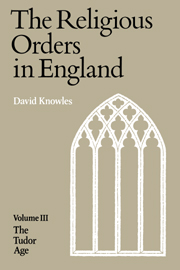Book contents
- Frontmatter
- Contents
- Preface
- List of Abbreviations
- Part One The Tudor Scene
- Chap. I The reign of Henry VII
- Chap. II Some monastic activities
- Chap. III The Cistercians
- Chap. IV The Premonstratensians
- Chap. V The friars in the early sixteenth century
- Chap. VI Sixteenth-century visitations
- Chap. VII Monastic personalities
- Chap. VIII Humanism at Evesham
- Chap. IX William More, prior of Worcester, 1518–36
- Chap. X Butley and Durham
- Part Two The Gathering Storm
- Part Three Suppression and Dissolution
- Part Four Reaction and Survival
- Appendix I Sir Thomas More's letter ‘to a monk’
- Appendix II Religious houses suppressed by Cardinal Wolsey
- Appendix III The witness of the Carthusians
- Appendix IV Houses with incomes exceeding £1000 in the Valor Ecclesiasticus
- Appendix V The sacrist of Beauvale
- Appendix VI Itinerary of the visitors, 1535–6
- Appendix VII The commissioners for the survey of the Lesser Houses in 1536
- Appendix VIII The conflict of evidence on the monasteries
- Appendix IX The last abbots of Colchester, Reading and Glastonbury
- Appendix X Regulars as bishops
- Bibliography
- Index
Chap. VII - Monastic personalities
Published online by Cambridge University Press: 08 January 2010
- Frontmatter
- Contents
- Preface
- List of Abbreviations
- Part One The Tudor Scene
- Chap. I The reign of Henry VII
- Chap. II Some monastic activities
- Chap. III The Cistercians
- Chap. IV The Premonstratensians
- Chap. V The friars in the early sixteenth century
- Chap. VI Sixteenth-century visitations
- Chap. VII Monastic personalities
- Chap. VIII Humanism at Evesham
- Chap. IX William More, prior of Worcester, 1518–36
- Chap. X Butley and Durham
- Part Two The Gathering Storm
- Part Three Suppression and Dissolution
- Part Four Reaction and Survival
- Appendix I Sir Thomas More's letter ‘to a monk’
- Appendix II Religious houses suppressed by Cardinal Wolsey
- Appendix III The witness of the Carthusians
- Appendix IV Houses with incomes exceeding £1000 in the Valor Ecclesiasticus
- Appendix V The sacrist of Beauvale
- Appendix VI Itinerary of the visitors, 1535–6
- Appendix VII The commissioners for the survey of the Lesser Houses in 1536
- Appendix VIII The conflict of evidence on the monasteries
- Appendix IX The last abbots of Colchester, Reading and Glastonbury
- Appendix X Regulars as bishops
- Bibliography
- Index
Summary
WILLIAM SELLING
The life of William Selling, monk and later prior of the cathedral monastery at Canterbury, was passed entirely within the bounds of the fifteenth century and, so far as the significant dates of his career go, it might have seemed more fitting to include his name along with that of Whethamstede, whose younger contemporary he was, than with those of the monks of the Reformation period. There is, however, a wider gulf between Whethamstede and Selling than between the latter and Kidderminster; Whethamstede passed through an awakening world with unseeing eyes while Selling, however limited his own creative powers may have been, at least recognized the new world and hoped to diffuse its spirit.
William Selling (?1430–94) took his monastic name from a village some four miles south-east of Faversham, and entered Christ Church as a boy. His family name was probably Tyll. He is found as prior taking an interest in the education of a boy, Richard Tyll, and Agnes Tyll, widow of William Tyll, was admitted to confraternity in the priory and granted, along with her husband, the privilege of sepulture in the cathedral near the body of St Thomas. The young monk was sent to Oxford, where he was a member of Canterbury College from 1454 till 1464, attaining to the priesthood in 1456 and to the B.D. in 1458.3 Letters written by him at this time are in a correct and concise Latin style that contrasts very favourably with that of Whethamstede; they show also a respect for the patronage of Prior Thomas Goldstone.
- Type
- Chapter
- Information
- The Religious Orders in England , pp. 87 - 99Publisher: Cambridge University PressPrint publication year: 1979



